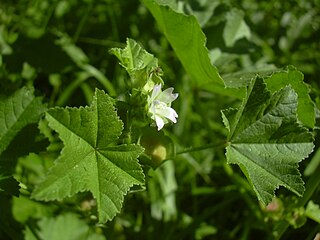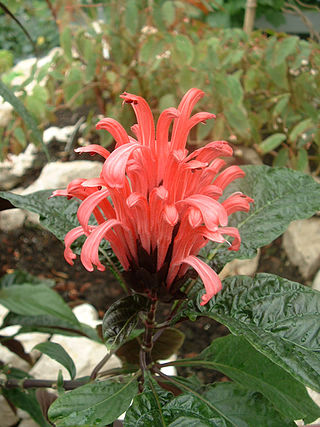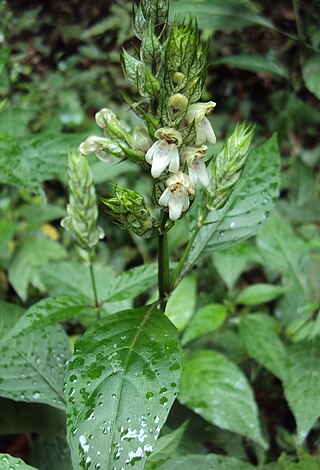
Acanthaceae is a family of dicotyledonous flowering plants containing almost 250 genera and about 2500 species. Most are tropical herbs, shrubs, or twining vines; some are epiphytes. Only a few species are distributed in temperate regions. The four main centres of distribution are Indonesia and Malaysia, Africa, Brazil, and Central America. Representatives of the family can be found in nearly every habitat, including dense or open forests, scrublands, wet fields and valleys, sea coast and marine areas, swamps, and mangrove forests.

Malvaceae, or the mallows, is a family of flowering plants estimated to contain 244 genera with 4225 known species. Well-known members of economic importance include okra, cotton, cacao, roselle and durian. There are also some genera containing familiar ornamentals, such as Alcea (hollyhock), Malva (mallow), and Tilia. The genera with the largest numbers of species include Hibiscus, Pavonia, Sida, Ayenia, Dombeya, and Sterculia.

Justicia is a genus of flowering plants in the family Acanthaceae. It is the largest genus within the family, encompassing around 700 species with hundreds more as yet unresolved. They are native to tropical to warm temperate regions of the Americas, India, and Africa. The genus serves as host to many butterfly species, such as Anartia fatima. Common names include water-willow and shrimp plant, the latter from the inflorescences, which resemble a shrimp in some species. The generic name honours Scottish horticulturist James Justice (1698–1763). They are closely related to Pachystachys.

The Rafflesiaceae are a family of rare parasitic plants comprising 36 species in 3 genera found in the tropical forests of east and southeast Asia, including Rafflesia arnoldii, which has the largest flowers of all plants. The plants are endoparasites of vines in the genus Tetrastigma (Vitaceae) and lack stems, leaves, roots, and any photosynthetic tissue. They rely entirely on their host plants for both water and nutrients, and only then emerge as flowers from the roots or lower stems of the host plants.

Hygrophila, commonly known as swampweeds, is a genus of flowering plants in the acanthus family, Acanthaceae. There are about 80 to 100 species, of which many are aquatic plants. The genus is distributed across the tropical and subtropical world. It is one of only two genera in its family that contains aquatic plants, the other being Justicia. The genus is treated in the tribe Hygrophileae, which is noted as being in need of revision at the genus level, meaning the current taxonomic boundaries of Hygrophila are likely to change in the future.

Poikilacanthus is a genus of flowering plants in the family Acanthaceae. It includes 13 species native to the tropical Americas, ranging from central Mexico to northern Argentina.

Nicoteba is a genus of flowering plants in the family Acanthaceae. It includes four species native to sub-Saharan Africa and the Indian subcontinent.
Acanthopale is a plant genus of shrubs or subshrubs in the Acanthaceae plant family. The genus name is based on the classic Greek words for thorn ákantha and stake palum. Some species in the genus are cultivated as ornamental plants.

Anisotes is a genus of Afrotropical plants in the family Acanthaceae. The genus is morphologically similar to Metarungia, from which it differs mainly in the dehiscence of the fruit capsule, and the nature of the placenta. Placentas remain attached to the inner surface of fruit capsules in Anisotes.

Odontonema, the toothedthreads, is a genus of flowering plants in the family Acanthaceae. It includes 32 species native to the tropical Americas, ranging from Mexico to Peru and southeastern Brazil.

Pseuderanthemum is a genus of plants in family Acanthaceae with a pantropical distribution.

Stenostephanus is a genus of plants in the family Acanthaceae. It includes 94 species native to the tropical Americas, ranging from northeastern Mexico to Bolivia and southeastern Brazil.
Barleriola is a genus of flowering plants belonging to the family Acanthaceae.

Symplectochilus is a genus of flowering plants belonging to the family Acanthaceae.
Cephalacanthus maculatus is a species of flowering plant belonging to the family Acanthaceae. It is a subshrub or shrub endemic to San Martín Region of Peru. It is the sole species in genus Cephalacanthus.
Chalarothyrsus amplexicaulis is a species of flowering plant belonging to the family Acanthaceae. It is a subshrub native to central and southwestern Mexico. It is the sole species in genus Chalarothyrsus.
Joan W. Nowicke is an American botanist from St. Louis, Missouri. She worked 27 years for the Smithsonian Institution, between 1972 and 1999, in the Department of Botany, from the National Museum of Natural History. Nowicke is a global reference as a palynologist, mainly due to her specialization in pollen morphology and its relationship with systematics, in addition to her extensive work in the area of Caryophyllales palynotaxonomy.
Herpetacanthus is a genus of flowering plants belonging to the family Acanthaceae. It includes 21 species native to the tropical Americas, ranging from Honduras to Panama in Central America, and from Ecuador and Peru to Bolivia, northern and eastern Brazil, Suriname, and French Guiana in South America.
Lophiocarpus is a genus of flowering plants belonging to the family Lophiocarpaceae.
Megalochlamys is a genus of flowering plants belonging to the family Acanthaceae.












